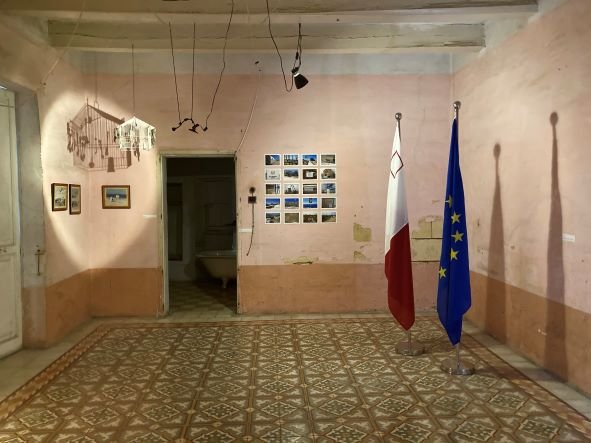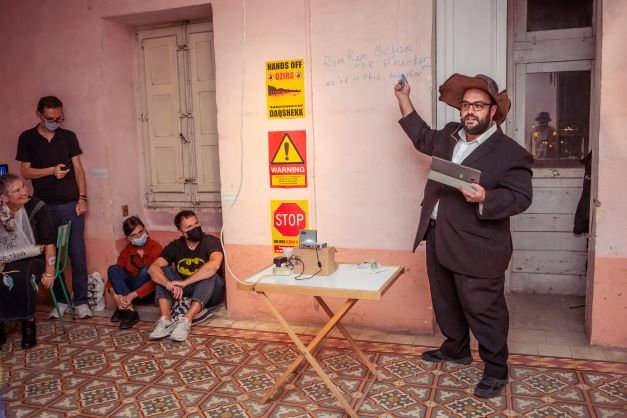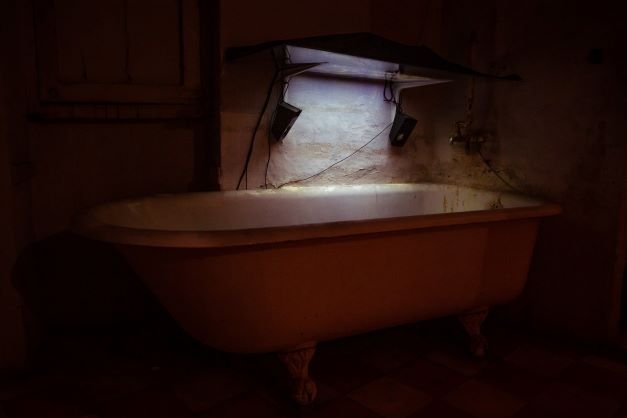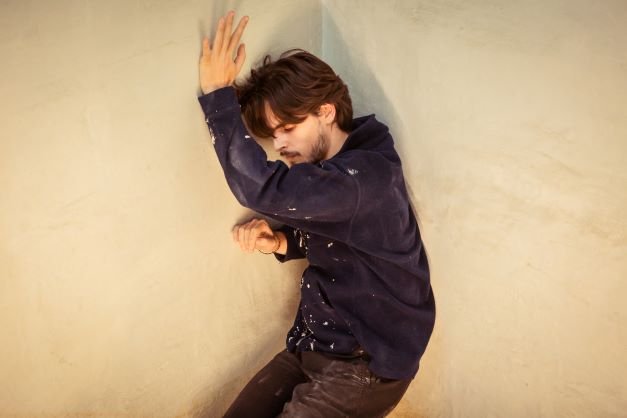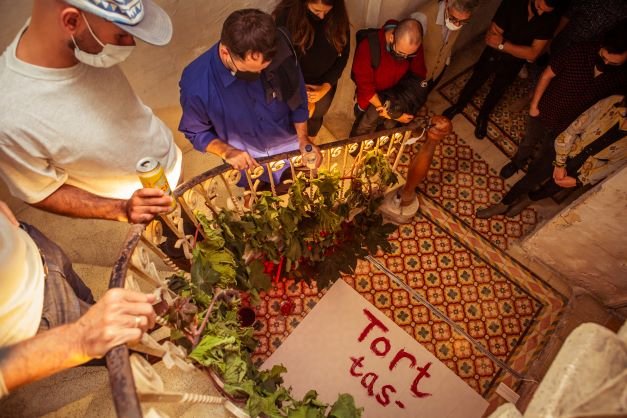
Debatable Land(s) Kalkara
The final Debtable Land(s) presentation took the form of a 3-day-long visual-performative-exhibition-festival, and was the culmination of the project’s 12 months of research and conversations, exploring how territories, lands and spaces are formed, and what conflicting interests influence these delineations.
The venue is one of the oldest houses in Kalkara. It was built around 1802, and is said to have been a type of infirmary. The cellars below this block also date back to the time of the Knights. The first and second floors were built in the early days of the British in Malta. Later, the house belonged to a Mariano Stivala - Marjanu, a freight-handler, who added a third floor to the building. During the war, he was well-off enough to be able to distribute food to the poor. He died under rubble in World War II during an air raid.
Contributors: Mohamed Ali ‘Dali’ Aguerbi & Chakib Zidi | Maria Attard | Fatima Amn | Keit Bonnici | Kristina Borg obo Batman Gżirjan | Johannes Buch | Josephine Burden | Florinda Camilleri | Tina Camilleri | Simone Cutajar | REA (Rachelle Deguara) | Charlene Galea | Justin Galea | Adrian Grima | Helen Horgan | Magna Żmien | Tom van Malderen & Charlie Cauchi | Caldon Mercieca | Greta Muscat Azzopardi | Niels Plotard | Margerita Pulè | Maren Richter | Klaus Schafler | Raphael Vella |
22 – 24 October
Casa Stivala, Triq ir-Rinella c/w Triq is -Sienja, Kalkara
Doors open 5pm – 9pm, Live interventions 7pm - 8pm
Live interventions | Friday 22 October
Mohamed Ali ‘Dali’ Aguerbi & Chakib | Dress Code (performative intervention)
Maria Attard | One divides into two, two does not merge into one - Response (talk)
Fatima Amn | Un/Earth (performance)
Rachelle Deguara | Tort ta' min? (performance)
Live interventions | Saturday 23 October
Tina Camilleri | Pluck (performance)
Dali Agrebi & Chakib Zidi | Dress Code (performative intervention)
Charlene Gálea | Ħawwel żerriegħa//Sow a Seed (performance lecture)
Caldon Mercieca | Hunters and Collectors Response
Live interventions | Sunday 24 October
Simone Cutajar | Strange Fruits Response
Klaus Schafler | Oh La La (performance)
Josephine Burden | The Shoreline (Fragments and Traces response)
Justin Galea | Confessions of a Maltese Pirate (performance)
Debatable Land(s)
Debatable Land(s) is the latest chapter of the long-term, research-based art project Fleeting Territories, resulting from the project Mapping Malta I- II, which took place in 2018. In the connection of the two actually opposing terms “fleeting” and “territory”, the Fleeting Territories project series see spatial coordinates not simply as stable or fixed values, but rather as aiding in the identification and negotiation of [in]visible mechanisms, which in turn organise and shape cities, land[scapes], human and more-than-human interconnections. Rights, laws, politics, and economies, as well as emotions play a central role in the appropriation of territories.
By forming temporary collectives and performative forums, Fleeting Territories ask questions such as which materialities and regimes of spatial concepts can be identified, and which artistic tools can be employed to measure and experience them.
The project's findings will be presented in Malta in October 2021.
Created by: Grammar of Urgencies (Maren Richter & Klaus Schafler), Greta Muscat Azzopardi, and Unfinished Art Space (Margerita Pulè)
Supported by Arts Council Malta - Project Support Fund & Kunsthalle Exnergasse, Vienna
Debatable Land(s) Chapters
These are the nine chapters which give structure to our body of research Debatable Land(s). The chapters are given loose interpretations, and are intended to foment debate and inspire thought.
Islandness
Islandomania /Tourism*Islandphobia/lawlessness*Islandphilia/Corruption*Islandism(outsourcing problems)*Post-Islandism (sourcing problems)*Islandification (paradise)*Counter-islandness(migration)*Agoraphobia*claustrophobia*acrophobia
Deserted Island, Financial hub, piracy, ‘lawlessness’, paradise (tourism), prison, utopia, outsourcing problems. The ideas and concepts of Island ranges from a physical space, a metaphor and a psychological state. How can we connect (to physical space) and disconnect (with old patterns or systems) and rather use ‘ISLAND’ as a powerful device for e.g caring, curing, (dis)comforting? Selected writings on islands reveal the island variously to be both real and imaginary, mythological and scientific, but as most problematic when constituted in political terms as a sovereign entity. Humans tend to reproduce what they know (“Robinson Crusoe Syndrome”)- a linear thinking of time and space. In order to live WITH the island in symbiosis an entire new set of relationships would be needed, as it seems. A cohabitant model of living.
What would change if we look at the land from the sea’s perspective or land as a storage of memory like in indigenous cultures? And why do phobias connected to the fear of space exist? Do we need to relearn our relationship to space/nature/the elements? How does land look like in this scenario in which land is not a commodification any longer?
One divides into two, two doesn’t merge into one
Symbiosis*cannibals*selfish entities*PARA-SITES and BASTARDS*Horizontal*vertical*three dimensional.
Zones, areas, sectors. Borders, boundaries, limits. This, quite often, is the language deployed in relation governance, and manifested in management tools for organising physical spaces. We aim for uniformity and unification instead of symbiosis or diversity, when we think of spatial organisation. Notions of jurisdiction, authority, sovereignty, administration etc. How to conceive the difference between two kinds of difference? What tools do we need to imagine land as something debatable and therefore make a One and another One dynamic, irregular, wayward, equal, empowering? (Un)commoning or futuring land, defining own space by producing the ‘Other’ space, shared, safe or open space, between the personal body, the environment, the public, the role of memory and history. How can we gain different narratives of ‘identity and belonging’ away from possessing space? As something, that is negotiation rather than a ‘selfish entity’(virus)? Parasiting or bastardisation?
What types of new physical and immaterial territories could we imagine? How do we see land compared with immaterial manifestation in Malta, e.g., visible and non-visible territories?
What is the difference between negotiating private and public land, the two main categories of land? What (new) criteria would we need to employ in order to create a third or even fourth category?
Is it about completion or separation?
Zeroland: Of Horizons and Trails in the sky
PIRATES*INVADERS*INNOCENT PASSAGE*FRONTIERS*FREEDOM OF THE SEA*REGRETS*COUNTRY WITHOUT LAND* (history) Sovereign Military Order of Malta*Unintentional Consequences (memorial)*(In)dependency*Contiguous zone*Ephemeral.
This chapter asks, what different ideas could be born from looking closer at fleeting notions of space like the ‘horizon’, a fundamental part of shaping the concept of islands?
Which contradicts the material space at the same time it relates to it? History tells us that when we start to move, we can easily transform the horizon into a frontier. Like the trail in the sky, the horizon destabilizes the idea of the is(land) as something tangible, constituted by time and space.
Traces of fleeting horizons.
The Shadow Lines
GHOSTS (fishing)*BUFFER ZONE*TRANSITION*Alternative History*Paradise*Hydrofeminism*‘Protection’* (Treaty of Amiens)*The other side*Immateriality
This chapter tries to refer to or narrate historical moments, temporal and geographical situations from an alternative perspective, perhaps also in an unusually different way.
Perspectives and points of view form a system of lines that bring together or separate geographies, people and discourses. Lines we have in mind and that are relevant and visible from one perspective but do not exist from another, only in an imagination of them.
A non-linear narrative built out of a web of memories from many people that never pretends to tell a big story. Instead, this is where various memories from different people come together containing different shades for the same experience.
Imaginary lines also serve as a metaphor for the actual political reality behind the creation of political constructions like nation states or the European Union, apparently immutable organisms fixed in nature.
An attempt is made to bring the arbitrariness of geographically drawn borders and cartographic delimitations into the foreground, to cross physical borders in order to show them as absurd and shady. A conceivable glimpse into the history of colonization.
The Mediterranean Sea, seen as both, as a metaphor and as a spatial visual language, imagining the world from the perspective of the seascape, and not from the land. How about narrating the territory, the land, the island, from the perspective of the sea as an alternative story?
Strange Fruit
Aliens*Invasive Species*Weaponised bodies - exploitation*Masks*Lynchings*Dazzle Camouflage*DNA*Rotten*sickly*luscious*saturation*THE OTHER*white nation*Borderless trade*trading borders*passport trade
This chapter asks: Given our history, what does it mean to belong here on this island? How do we determine which plants, animals, organisms, ideas are beneficial, which harmful?
Robin Wall Kimmerer talks about the “colonising” loosestrife, kudzu, and cheat grass that have the habit of taking over others’ homes and growing without regard to limits, vs the “naturalized” Plantain that is useful, fits into small places and coexists, so prevalent that we think of it as native.
Knowing our past, when foreigner has often meant dangerous, how do we expand our capacity to be in harmony with the unfamiliar, the uncomfortable? Daphne Caruana Galizia and Lassane Cisse both paid the ultimate price for their perceived power to upset the status quo. How do we respond to behaviour that threatens our wellbeing?
How has the Covid-19 pandemic affected ideas about who is welcome or shunned? What absurdities has it brought to the surface?
Fragments and Traces
Fragments*De-historicising the archive*Colonial monuments*archaeological remains*Għar Dalam*Taxonomy*Self-definition*Soil*Panama papers as archaeology*Ashes*Erosion*Extraction of resources and data*Offshore
What and whose stories have we pieced together so far from the fragments of history that we have access to? Are there other stories that can and need to be told at this time?
Are Algorithms the new coloniser? Using fragments of information, and traces left behind by our online actions to create a new world order that we must comply to?
Hunters and Collectors
Argonaut and Cricket*commodification*shelter*appropriation*welcome*
homing*solitude and conviviality*bucolic scenery*queering
Hunters, collectors, farmers, trappers, poachers, buyers, builders, inventors, investors – they all need land. Land that needs to be quantified, qualified, measured, weighed and valued. Before aeroplanes were invented, map-making was done using a triangulation technique, dividing the earth’s surface (or any area) into a network of triangles, in order to calculate distances and areas. Interestingly triangulation is also a manipulative device to engineer rivalry between two people – a sort of small-scale ‘divide and conquer’.
The capitalisation of living matter produces a new political economy (Rosi Braidotti) - the monetisation of living organisms in nothing new, and the human race has long bestowed upon itself a quasi-sacred, inalienable authority over other living beings.
How much physical land do we actually need to survive? How much water, how much soil, and how much light? How much metal, coal and plastic?
It may be time for a new land reform, and a new way of thinking about who owns which land. Ambiguous areas such as the coastline and rural lands are particularly in need of protection from enclosure and privatisation.
Land is the only thing that lasts.
The next Revolution will not be funded (or televised)
Oxygen*utopia*menagerie*hysteria*radical*dissent*democracy*convulsions*uprisings*fake news*paranoia*bread revolution*migration*radical care
This chapter wants a cheap rebellion - a budget insurgence. Franz Fanon spoke of the true revolution, that “changes man and renews society” – it is this renewal and oxygen that we need, but do we want it and can we afford it? Do we even know what we want? What would the world look like, the day after the revolution?
Is a revolution against economic growth possible through a bacchanalian vision of the Mediterranean lifestyle of pleasure, instead of through violence or hardship? This chapter proposes a decolonisation through sloth – without hard graft, there would be no economic development, no investment potential, and therefore no private take-overs of public land.
Alternative modes of revolt do exist – radical care can be seen as an act of revolution. The creation of art is a statement against money-making production - simply doing nothing inherently inverts capitalist logic of value.
The target of a revolution is not always clear - is it a coloniser, and if so, coloniser of what?
Terrain Vague
The Joker*unpredictable*disobedient*informal*unwanted*wasteland*coastline*
grey areas*staying wayward*rooftops*shifting borders*ecosexuality.
This chapter takes inspiration from an ugly, useless urban non-space – grey, cracked concrete and abandoned warehouses. Like an awkward teenager it sulks and snots through alternate moments of deviancy and divinity.
Terrain vague is defined by Ignasi de Solà-Morales as land in a “potentially exploitable state but already possessing some definition to which we are external”. Its future use and value are unknown, and up for debate or negotiation – which gives this chapter a subversive and free quality.
This wasteland presents a counterpoint to the consumerism and bustle of the city – an enforced idleness is itself an anathema to busy -ness. Therefore, within this chapter exists an opportunity to pause, change direction or do something unpredictable.
It’s also a sloppy clause in a contract – that grey area that’s less precise than it should be. But there’s always something to be gained in that by those who play their cards right.
Because a wasteland is never completely barren – weeds grow through the cracks, and garbage takes on an alternate identity. Nothing begets nothing.
Performative Debates
During a series of performative debates, experts from different fields were invited to question definitions of borders, physical and non-physical boundaries, and to consider the definition of a 'debatable' land, through a series of chapters to be debated.
Islandness | Kathrin Schoedel, JD Farrugia, Adrian Grima, Fatima Amn
Hunters and Collectors | Helen Horgan, Gianmarco Santirocco, Matthew Tanti, Raffaella Zammit
One Divides Into Two, Two Doesn’t Merge Into One | Maria Attard, Kristina Borg, Elisabeth Condrad, Julian Evans
The Next Revolution Will Not Be Funded (Or Televised) | Florinda Camilleri, Mario Gerada, Asha Singh, Mina Tolo
Zeroland: Of Horizons and Trails in the Sky | Gilbert Calleja, Ruth Marguerat, Karsten Xuereb, Kristian Zarb Adami
Strange Fruit | Simone Cutajar, Monique Agius, Ira Melkonyan, Maria Pisani
The Shadowlines | Mohamed Ali (Dali) Aguerbi , Nadine Castillo, Reuben Grima, Caldon Merceica
Fragments and Traces | Elise Billiard Pisani, Joanna Demarco, Charlene Ellul, Charlene Galea
The debate hosts | Greta Muscat Azzopardi, Margerita Pulè, Maren Richter, Klaus Schafler
Debatable Land(s)
Kunsthalle Exnergasse (KEX), Vienna
October 2020
The exhibition at Kunsthalle Exnergasse (KEX) in Vienna in 2020 was conceived as an experimental spatialised research-project in the framework of the Fleeting Territories series.
The exhibition »Debatable Land(s)« is conceived as an experimental spatialised research-project in the framework of the Fleeting Territories series by Grammar of Urgencies. By forming temporary collectives and performative fora, Fleeting Territories identifies materialities and regimes of spatial concepts, and searches for the artistic tools that can be employed to measure and experience them.
This installation at Kunsthalle Exnergasse (KEX) is the first phase of a year-long process, which proposes a body of research contributing to the emergence of dialectic debating and decision-making. The term ›debatable land‹, which we borrow for our project, originally referred to a piece of land where sovereignty was in question; this land and its borders were intangible for centuries, until a map of the territory was drawn, and it became a ›knowable place‹. Lines-on-a-map as a result of claims of belonging – which have tended to escape the rigorous theorisation of other key concepts of space – are themselves not free of ambiguities. In our search for generative concepts of belonging - which reflect on the texture of how it is felt, used, and practised - we take Malta as a case study. In particular, we consider the emotional aspects of belonging and how it is enacted by myriad humans and ›more-than-humans‹. Belonging is understood as emergent co-becoming, which may allow for new, emotional geographies that are simultaneously caring and careful.
Our research is not presented as a chronological narrative, or as a logical chain of arguments towards one perfect or imperfect state. Rather, it can be seen as a reflection on the sporadic, random, and sometimes oblique nature of human action and global events, and on the shifting nature of power, historical narrative, and collective memory.
With its land, sea, underwater, and aerial borders, the island state of Malta serves »Debatable Land(s)« as a mirror of the many chronicles of power-plays, migration, exploitation, and the instinct
for self-preservation. The borders around the archipelago of Malta seem well defined, whereas the aerial, sea, and virtual borders remain blurred. Borderlines as such can be seen as places of risk, symbols of a step into the unknown, or a ›nothing place‹ that is simultaneously a place on a map, a black line, or a void (Stonor Saunders, 2020). Under the lens of a microstate like Malta, events become magnified – nevertheless, they are not exclusive to this archipelago, and our viewpoint shifts from the minutiae to the global spectacle. While archival material, newspaper reports, and historical research are presented and referred to, the exhibited materials and artefacts recognise that information does not equate with knowledge, and historical record is just that – a record – not the event itself (Mantel, 2017). Similarly, we take facts, current events, and behaviours – like border controls, coercive behaviours, or populist rhetoric – as symbolic tokens of the ideologies they represent.
The »Debatable Land(s)« research is structured as a series of questions, but – as in a plebiscitary democracy – we know that power lies with those who design the questions (Ali, 2020). We sift through an abundance of information and data, not to accumulate more knowledge, but to construct alternative meanings – an act, event, law enacted can ultimately mean less than a memory, smell, a flash of insight. These questions form the basis of the Debatable Land(s) performative debates which will take place in Malta in 2021.
Along with our materials displayed in nine, loosely-formed chapters, a number of artists and collaborators were invited to contribute to our experiment at KEX.
The exhibition was opened with live-streamed performances by Mohamed Ali ‘Dali’ Aguerbi & Chakib Zidi, Roxman Gatt, and a contribution from Antoine Cassar.
View recorded event here.
Tobias Zielony’s practice draws on a documentary tradition, uncovering lesser-known histories of sites and people. »Hurd’s Bank« (2019) observes the space that lies beyond legality, corruption, international law, and the oil trade. The film is centred around Hurd’s Bank, a sea bank outside Maltese territorial water, where oil ships wait to depart. It combines historical fact and journalistic findings, dream accounts and snippets of conversations in Malta, to form a powerful narrative somewhere between poetry and fact. The images capture the dark sea, and a narrator’s voice mingles truth with fiction, expanding the island state into an extraterritorial space that is a law unto itself.
Visible and invisible interplays between the exploitation of natural resources, power, and neo-colonialism are also present in »Kerogen Voices: Man-Made Earthquakes« (2020), an installation by Jimmy Grima and the rubberbody collective. The work speaks about man-made earthquakes caused by various methods of extracting fossil oil, gas, and other minerals from the ground. Research on this planetary phenomenon began in Malta, but led to the Netherlands, the source of the liquefied gas stored off the island’s coast. The gas bubble under Groningen is the largest known gas deposit in Europe; consequently, the region’s induced seismicity is an area of intense geological study. Voices of science and myth – of workers, engineers, and entrepreneurs, of elves and generations of humans – enter into a dialogue through densely layered streams of text and sound, creating an ominous vision of infinite growth and production.
Letta Shtohryn researches what could be called the ›algorithmic truth‹, exploring the fine line between fact and myth-making and our intertwined coexistence with the digital realm. As a method, she employs speculative strategies, poetics, and metaphysical investigations to respond to aspects of digital developments using video games, commercial goods, and imagery. Her work »Offshore Bakery« (2019) examines offshore schemes and the global spiderweb of interconnected companies, taking us to an alternate reality of a street in Malta’s capital Valletta, where traditional bakeries have been replaced by offices. What appear to be regular buildings on the outside are hiding something behind the magical protective shield of their façades.
Charlene Galea explores gender constructs as part of her female identity. Employing her body as both instrument and subject, she navigates between online identity and physical experience, presenting the lived-in female body in contemporary times. The series »Island Girls« (2020) places women in surreal locations, and reflects upon the dystopian aspects of the #IslandGirls hashtag in conflict with the supposed tropical paradise it seeks to evoke. #IslandGirls on Instagram typically displays bikini-clad female bodies in tempting poses on exotic beaches. Here, however, the female body becomes an empowered and autonomous political body, conscious of its environment and in command of its actions.
A critical examination of the politics of imagery and therefore representation inevitably leads to an analysis of history and memory. Malta’s history is fragmented – due in part to turbulent episodes of occupation and oppression as a result of foreign military and economic interests. Magna Żmien is a community project that aims to place tacit local knowledge, community memories, and micronarratives on par with grand narratives of hegemonic representation in Malta. The project engages with individuals and communities, digitising and preserving personal analogue audio-visual, sound and photographic collections, with the aim to create an alternative archival narrative.
What material, symbolic, aesthetic, political, or social connotations can be produced in a dialectic field of references by way of dehistoricising archival memories from the supremacy of a historical discourse? The ›archival‹ has long been of interest to artists, especially in practices which use and subvert its function. In doing so, they highlight a systematic and perhaps irrevocable crisis in institutional and state-ordained archiving around the globe.
Bettina Hutschek frequently addresses this quandary of translating historical events into one single narration, using fictional elements to traverse those narratives. The source material for her contribution, »Knights of the Order« (2020), is a 1990s historical documentary that traces the history of Malta’s erstwhile governors, the Order of the Knights Hospitallers - on YouTube the documentary comes with subtitles that were created by early speech recognition software. The artist has selected hundreds of screenshots in which filmic images and subtitles clash in a confusion of speech recognition, twenty-first century subtitles, and historical imagery. By presenting these images with corrupted subtitles, the history of a colonial, patriarchal power system, such as the Knights of Malta, is revised and rendered ad absurdum.
Absurdity is likewise Keit Bonnici’s filter on Malta’s history: »Is it easier to get an honest reply from her or win the lottery?« (2020) is a postcard project that attempts to reconfigure thinking around identity, icons, and history. While the world has recently insisted upon the removal of monuments to colonisers and slavers, Malta held its own half-hearted discussion on the presence of a large statue of Queen Victoria in Valletta. The monument has remained in place – however, the artist sent a carefully made postcard to Queen Elizabeth II, asking her how she feels about the debate surrounding the statue of her great-great-great-grandmother. Although the postcard was sent in July 2020, he has yet to receive a reply.
Migration – to, from, and via Malta – has long been part of the island’s history. Guy Woueté takes a performative approach in the development of his projects, while the colonial past of Cameroon plays a major role in his practice. Using history as source material, Woueté combines records of personal experience in collage, installation, performance, video, and photography. His project »Next Week« (2010), which consists of two films, compiles interviews and images of migrants in Malta. The films capture the hope among migrants and present the act of walking as a form of resistance. The title of the work refers to the concept of »Thirdspace« as articulated by Edward Soja, drawing attention to the notion of space as a thought model and vehicle of social processes.
Charlie Cauchi, a documentary filmmaker, who herself grew up in the Maltese diaspora of the UK, has worked extensively in recent years on chronicling the stories of Maltese migrant communities abroad, attempting to distill the complex topic of Maltese migration to countries such as the USA, Canada, or Tunisia. Her work »Ħanina« (2018), roughly translated as ›kind‹, brought her to Tunisia, where throughout the nineteenth and twentieth centuries many Maltese chose – or were forced – to make a life for themselves. Ezzahra is an industrial town, with a palpable similarity to Malta in its signage, colours, and vernacular architecture. Today, the Maltese migrant worker community has all but disappeared, but the exchange of labour remains. At Bortex’s Ezzahra factory, the Maltese firm produces their Gagliardi suiting line, employing a skilled Tunisian workforce to produce fine Maltese tailoring – an operation captured between glimpses of landscape and the world beyond the factory.
References
Stonor Saunders, Frances. »The suitcase«. London Review of Books 42, no. 15 (July 30, 2020).
Mantel, Hilary. »Why I became a historical novelist.« The Guardian (June 3, 2017).
Ali, Tariq. »The Decline of Democracy and its Consequences.« online interview. Conter (July 10, 2020).
